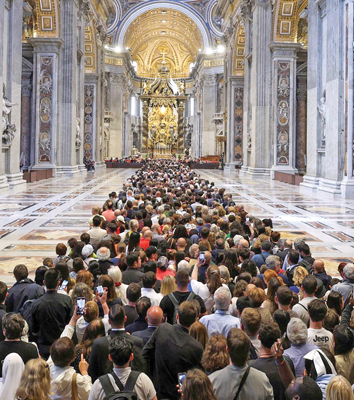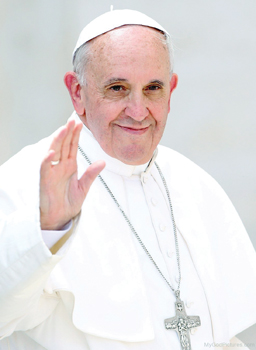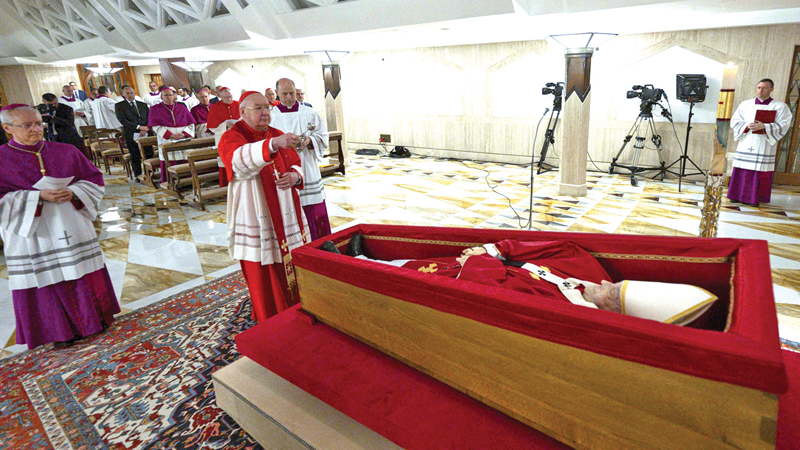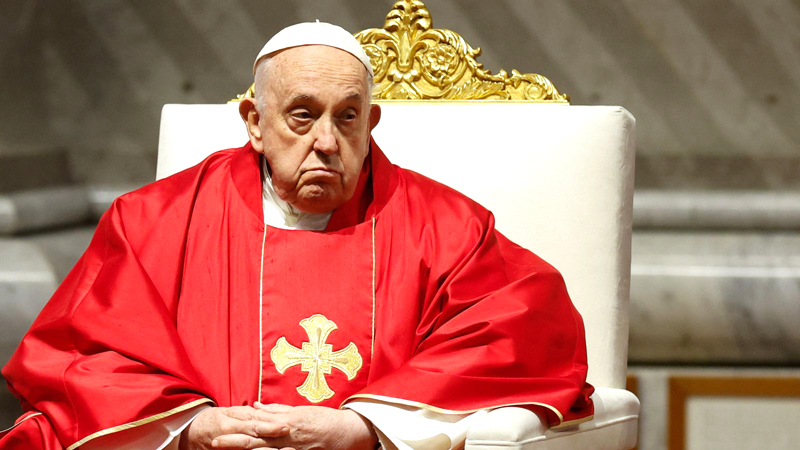Just a day after extending his Easter greetings and calling for a ceasefire in Gaza, Pope Francis passed away on Easter Monday, April 21, 2025, at 7.35 a.m. at the Vatican’s Casa Santa Marta. The 88-year-old pontiff, born Jorge Mario Bergoglio, had been battling bilateral pneumonia and declining health for months. The Vatican, in a statement by Cardinal Kevin Farrell, confirmed his death, describing him as “a true disciple of the Lord Jesus” who lived for “the poorest and most marginalised.”
 His rise to the papacy was as unorthodox as his leadership. Born on December 17, 1936, in Buenos Aires to Italian immigrant parents, Pope Francis worked a variety of humble jobs—including sweeping floors, working as a janitor, chemical technician and even a nightclub bouncer. It was a spontaneous confession to a priest he had never met that changed the course of his life and led him to the Jesuit order, where he was ordained a priest in 1969 and later became Archbishop of Buenos Aires.
His rise to the papacy was as unorthodox as his leadership. Born on December 17, 1936, in Buenos Aires to Italian immigrant parents, Pope Francis worked a variety of humble jobs—including sweeping floors, working as a janitor, chemical technician and even a nightclub bouncer. It was a spontaneous confession to a priest he had never met that changed the course of his life and led him to the Jesuit order, where he was ordained a priest in 1969 and later became Archbishop of Buenos Aires.
A Pope of firsts
Pope Francis was the first Jesuit Pope, the first from the Americas and the first non-European pope in nearly 1,300 years. His choice of the name “Francis” was a nod to St. Francis of Assisi and symbolised his lifelong commitment to humility and service. His papacy was marked by deep compassion, sweeping reform and tireless advocacy for peace, the environment and the disenfranchised.
Pope Francis’ Final Wish: “No Marble, no Gold, just earth”
In death, as in life, Pope Francis remained a symbol of humility. According to the Vatican, his final wish was to be buried without grandeur, in plain earth, with no marble, gold, or elaborate tomb. He chose not to be laid to rest in St. Peter’s Basilica like most of his predecessors. but instead at the Basilica of Saint Mary Major, a place of deep personal significance. His grave will be marked simply with the Latin inscription Franciscus.
Pope Francis’ final public appearance was his Easter message, delivered just one day before his death. In it, he called for peace in Gaza and unity among nations. His passing has elicited a global outpouring of grief and tributes. U.S. President Donald Trump ordered flags at half-staff, while India’s government declared a three-day state mourning. Argentina, his homeland, suspended football matches in his honour and a minute’s silence will be observed at all games for the rest of the week.
Novendiale: Mourning and the Path Ahead
 The Church has now entered sedevacante, the period between pontificates. A nine-day mourning ritual known as Novendiale has begun, during which Holy Masses are held. Francis’ body was lying in state in St. Peter’s Basilica for public veneration. His funeral Mass was scheduled yesterday, April 26, at 10.00 a.m. (local time) in St. Peter’s Square. It was presided over by Cardinal Giovanni Battista Re, the current dean of the College of Cardinals.
The Church has now entered sedevacante, the period between pontificates. A nine-day mourning ritual known as Novendiale has begun, during which Holy Masses are held. Francis’ body was lying in state in St. Peter’s Basilica for public veneration. His funeral Mass was scheduled yesterday, April 26, at 10.00 a.m. (local time) in St. Peter’s Square. It was presided over by Cardinal Giovanni Battista Re, the current dean of the College of Cardinals.
Heads of State, religious leaders and thousands of faithful are expected to attend the ceremony. Among the confirmed dignitaries are French President Emmanuel Macron, U.S. President Donald Trump and Argentine President Javier Milei. The funeral included ancient rites, including the Ultima commendatio and Valedictio, symbolic farewells offered to the deceased pontiff.
The Sede Vacante and the Conclave
In keeping with ancient Vatican tradition, the death of Pope Francis was confirmed through a solemn and symbolic ritual. The Camerlengo, Cardinal Kevin Farrell, approached the deceased Pope and gently tapped his head three times with a silver hammer while calling his baptismal name: “Jorge Mario Bergoglio, are you asleep?” Receiving no response, he declared the Pope officially dead.
Following this, the Fisherman’s Ring, an ornate gold ring engraved with the Pope’s name and used to seal official documents, was ceremoniously destroyed. Traditionally, this act is performed with a hammer in the presence of several witnesses to prevent the ring from being used for forgery. The destruction of the ring marks the definitive end of the pontificate and the beginning of the sedevacante, the interregnum period when the papal seat is vacant.
During this time, the governance of the Church is temporarily overseen by the College of Cardinals. The Camerlengo, currently Cardinal Kevin Farrell, administers the temporal affairs of the Vatican. His responsibilities include verifying the pope’s death, sealing the papal apartments, and organizing the logistics of the conclave.
The conclave, a term derived from the Latin cum clave, meaning “with a key”refers to the locked-door gathering where the next pope is chosen. It takes place in the Sistine Chapel, under Michelangelo’s famed fresco of The Last Judgment. Strict rules ensure secrecy: cardinals are sequestered, their communications cut off from the outside world. Even the Vatican is equipped with electronic jamming devices to prevent leaks.
 Only cardinals under the age of 80 are eligible to vote. Currently, 135 cardinal-electors from over 70 countries will participate. Pope Francis himself appointed 108 of them, which means his progressive theological influence may heavily shape the outcome.
Only cardinals under the age of 80 are eligible to vote. Currently, 135 cardinal-electors from over 70 countries will participate. Pope Francis himself appointed 108 of them, which means his progressive theological influence may heavily shape the outcome.
Each day, cardinals vote up to four times; twice in the morning, twice in the afternoon. Ballots are burned after each session: black smoke (fumatanera) signals no decision, while white smoke (fumatabianca) announces that a new pope has been elected. When consensus is reached, a two-thirds majority is required and the chosen cardinal is asked, “Do you accept your canonical election as Supreme Pontiff?” Upon acceptance, he selects a papal name and is clothed in papal vestments before stepping out onto the balcony of St. Peter’s Basilica to deliver the traditional UrbietOrbi blessing.
Meanwhile, speculation is rife on who the next Pope would be. While it is not certain if the next pope would be selected from the list of expected candidates, there are a few front runners that are being considered.
Several prominent international media outlets have named Sri Lanka’s Archbishop of Colombo, Cardinal Malcolm Ranjith, as a potential candidate to succeed Pope Francis. In their coverage of likely papal successors, publications such as the Washington Examiner, USA Today and The Times of India have listed Cardinal Ranjith among high-profile global figures, highlighting his growing recognition within the Catholic Church.
The Washington Examiner featured Archbishop Ranjith alongside other prominent candidates including Cardinal Luis Tagle (Philippines), Cardinal Jean-Marc Aveline (France), and Cardinal PietroParolin (Italy). USA Today also included a broader list of contenders that featured Cardinals Matteo Zuppi, Gerhard Müller, Robert Sarah and Raymond Burke.
The Times of India, quoting international Catholic news sources, described Ranjith as a “dark horse” in the papal race, noting his strong conservative theological views and his representation of the Global South, factors that could resonate in the evolving dynamics of the Church. Similarly, The Washington Times highlighted his traditionalist leanings, including support for the Latin liturgy and opposition to same-sex marriage.
Despite the speculation, Church officials in Sri Lanka have clarified that the papal election does not operate on declared candidacies. Fr. Cyril Gamini Fernando of the Archdiocese of Colombo had reportedly stated that there is no such thing called contenders for the papacy, adding that anyone out of the 252 members in the College of Cardinals can be elected. Only 117 cardinals are eligible to vote in the conclave.
Fr. Jude Krishantha, National Director of Catholic Mass Communications, acknowledged Cardinal Ranjith’s reputation among his peers, stating that he remains a respected and well-known figure within the College of Cardinals.
While no clear frontrunner has emerged, Cardinal Ranjith’s inclusion in multiple global reports reflects the increasing consideration being given to leadership from outside the traditional European strongholds of the Church.
However, given that 108 of the current cardinal-electors were appointed by Francis, his theological imprint will likely influence the outcome.
Legacy of a humble giant
Pope Francis leaves a legacy not of buildings or riches, but of hearts transformed and systems questioned. His focus on mercy, his call for environmental stewardship and his inclusive vision of the Church made him beloved by millions and controversial among some. He lived the Gospel through simplicity and service.
As the world awaits the white smoke from the Sistine Chapel, one truth remains: Pope Francis changed the very nature of the papacy. And as he requested, the earth, plain and unadorned, will now hold his body, but his message will echo far beyond.





